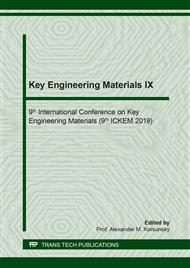[1]
V. C. Li, On engineered cementitious composites (ECC) a review of the material and its applications, Journal of Advanced Concrete Technology. 1 (2003) 215-230.
DOI: 10.3151/jact.1.215
Google Scholar
[2]
G. Parra-Montesinos, High-performance fiber-reinforced cement composites: an alternative for seismic design of structures, ACI Structural Journal. 102 (2005) 668.
DOI: 10.14359/14662
Google Scholar
[3]
S. Qudah, and M. Maalej, Application of engineered cementitious composites (ECC) in interior beam–column connections for enhanced seismic resistance, Engineering Structures. 69 (2014) 235-245.
DOI: 10.1016/j.engstruct.2014.03.026
Google Scholar
[4]
S. H. Said and H. A. Razak, Structural behaviour of RC engineered cementitious composite (ECC) exterior beam–column joints under reversed cyclic loading, Construction and Building Materials. 107 (2016) 226-234.
DOI: 10.1016/j.conbuildmat.2016.01.001
Google Scholar
[5]
F. Yuan, J. Pan, Z. Xu, and C. K. Y. Leung, A comparison of engineered cementitious composites versus normal concrete in beam-column joints under reversed cyclic loading, Materials and Structures, 46 (2013) 145-159.
DOI: 10.1617/s11527-012-9890-6
Google Scholar
[6]
R. Zhang, K. Matsumoto, T. Hirata, Y. Ishizeki, and J. Niwa, Application of PP-ECC in beam–column joint connections of rigid-framed railway bridges to reduce transverse reinforcements, Engineering Structures. 86 (2015) 146-156.
DOI: 10.1016/j.engstruct.2015.01.005
Google Scholar
[7]
S. W. Lee, S.-B. Kang, K. H. Tan, and E.-H. Yang, Experimental and analytical investigation on bond-slip behaviour of deformed bars embedded in engineered cementitious composites, Construction and Building Materials, 127 (2016) 494-503.
DOI: 10.1016/j.conbuildmat.2016.10.036
Google Scholar
[8]
S. W. Lee, Seismic behaviour of engineered cementitious composites beam-column joints. PhD Thesis (2017), Nanyang Technological University, Singapore.
DOI: 10.32657/10356/69967
Google Scholar
[9]
R. Zhang, K. Matsumoto, T. Hirata, Y. Ishizeki, and J. Niwa, Shear behaviour of polypropylene fiber reinforced ECC beams with varying shear reinforcement ratios, Journal of JSCE. 2(2014) 39-53.
DOI: 10.2208/journalofjsce.2.1_39
Google Scholar
[10]
C. H. Yaw and J. B. Han, The Mechanical Behaviour of Fiber Reinforced PP ECC Beams under Reverse Cyclic Loading, Advances in Materials Science and Engineering. (2014) 1-9.
DOI: 10.1155/2014/159790
Google Scholar
[11]
S.W. Lee, C.L. Oh and M.R.M Zain, Evaluation of the design mix proportion on mechanical properties of engineered cementitious composites. Key Engineering Materials. 775(2018) 589-595.
DOI: 10.4028/www.scientific.net/kem.775.589
Google Scholar
[12]
Ridzuan, A. R. M., Ibrahim, A., Ismail, A. M. M., & Diah, A. B. M., Durablity performance of recycled aggregate concrete. In Achieving Sustainability in Construction: Proceedings of the International Conference held at the University of Dundee, Scotland, UK (2005) 193-202.
DOI: 10.1680/asic.34044.0023
Google Scholar
[13]
Anuar, K. A., Ridzuan, A. R. M., & Ismail, S., Strength characteristics of geopolymer concrete containing recycled concrete aggregate, International Journal of Civil & Environmental Engineering. 11(1)(2011) 59-62.
Google Scholar
[14]
V.W.Y. Tam, X.F. Gao, C.M. Tam, Microstructural analysis of recycled aggregate concrete produced from two-stage mixing approach, Cem. Concr. Res. 35 (6) (2005) 1195-1203.
DOI: 10.1016/j.cemconres.2004.10.025
Google Scholar
[15]
A. Katz, H. Baum, Effect of high levels of fines content on concrete properties, ACI Mater J. 103 (6) (2006) 474-482.
Google Scholar
[16]
C. Meyer, The greening of the concrete industry, Cem. Concr. Compos 31 (8) (2009) 601-605.
Google Scholar
[17]
J.Li, E.H. Yang, Macroscopic and microstructural properties of engineered cementitious composites incorporating recycled concrete fines. Cement and Concrete Composites. 78(2017) 33-42.
DOI: 10.1016/j.cemconcomp.2016.12.013
Google Scholar


